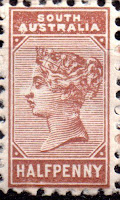Next
PICK OF THE
GREATEST
COLLECTIONS
Here, in one spectacular display, are 53 of the rarest
gems picked from the world's great stamp collections.
LIFE's estimate of values is given, but because
stamp economics is highly volatile the actual
selling price might be higher or lower. Below, with
the identification, are the names of owners or custodians
(three owners who prefer anonymity are listed
as " Atlanticus," "Pacificus" and " Arcticus"):
1 - Mauritius (British island east of Madagascar),
1848, earliest impression; Pacificus.
2 - Sweden,
1855, rarest stamp of Europe, error, should be bluegreen
instead of yellow; Dr. Hans Lundberg, Toronto,
Canada.
3 - Honduras, 1925, world's rarest airmail;
Oscar Lichtenstein, Rumson, N.J.
4 - Great
Britain, 1864, plate 77; British Museum.
5 - Mauritius,
1847; Queen Elizabeth.
6 - St. Louis, Mo.,
1845, greenish paper, Postmaster Provisional (a
stamp issued by a local U.S. postmaster before government
-issued stamps); Raymond H. Weill Co.,
New Orleans.
7 - Switzerland, 1850, with complete
frame around central cross not on later printings;
Dr . Hans Leeman, Geneva.
8 - Moldavia, 1858; Philip
Ward Jr., Philadelphia.
9 - Western Australia,
1854, Inverted Swan; Ward.
10 - Naples, 1860;
Theodore Champion, Paris.
11 - Canada, 1868, on
laid paper (on wove paper same stamp worth only
$2) ; K. Bileski, Winnipeg, Canada.
12 - New Zealand,
1855; Maurice Burrus, Strasbourg, France.
13 - Newfoundland, 1919; Arcticus.
14 - Mauritius,
1848, with "pence" misspelled "penoe," earliest
impression; Burrus.
15- Baden, 1851, color error,
should be rose instead of blue-green; Champion.
16- Transvaal, 1869, dark-green tete-heche pair;
Br itish Museum.
17- Great Britain, 1902; Robert J.
Gill, Baltimore.
18- France, 1849, vermilion block,
with tete-heche pair; Champion.
19- Hawaii, 1851,
unused, Missionary (so called because it was commonly
used by missionaries); Burrus.
20- Uruguay,
1858, tete-heche pair; Atlanticus.
21 - Zurich, 1843;
Leeman.
22- Geneva, 1843, strip of three doublestamps;
Leeman.
23- Uruguay, 1858, tete-heche
pair; Atlanticus.
24-Bavaria, 1849, tete-heche pair
in block of 12; Atlanticus.
25- British Guiana,
1852, block of four; Stolow, New York.
26- Egypt,
1926, block of four from sheet of 25 (price quotEll:
l is for all 25); ex-King Farouk.
27- New South
Wales, 1850; British Museum.
28- Moldavia, 1858,
tete-heche pair ; estate of ex-King Carol of Rumania.
29- Natal, 1902; Champion.
30-Uniontown, Ala.,
1861, two cents, Confederate Postmaster Provisional
; H.R. Harmer Inc., New York.
31 - Austria, 1856,
6-kreuzer, newspaper stamp; Champion.
32- Cape
of Good Hope, 1861, four-pence blue, with one-penny
error; Atlanticus.
33-Reunion, 1852; Champion.
34-Portuguese Guinea, 1881, overprinted
Cape Verde stamps with one, through Portuguese
post-office error, printed "Mozambique"; Champion.
35- Moldavia, 1858, unused; Champion.
36-
Honduras, 1925, red air-mail overprint; Lichtenstein.
37- Basel, 1845, first stamp printed in multicolor;
Leeman.
38- France, 1869, five francs, value
omitted by error; Champion.
39-British Columbia,
1865; Atlanticus.
40- Saxony, 1851, error,
should be gray instead of blue; Champion.
41 - Canada,
1851; Atlanticus.
42- British Guiana, 1856,
printed on sugar wrapping paper; J. & H. Stolow.
43- Brazil, 1843, 30 reis pair together with 60 reis;
estate of Y. Souren, New York.
44-Newfoundland,
1927, De Pinedo ; Mrs. Caroline Cromwell, New
York.
45-:-Mauritius, 1847, unused; Champion.
46- Gold Coast, 1883, one penny on four pence;
British Museum.
47-Spain, 1851, error, should
be red instead of blue; British Museum.
48- Millbury,
Mass., 1846, Postmaster Provisional; Weill
Co.
49-Tuscany, 1860; Champion. 50-France,
1850, tete-heche pair; Champion.
51-Newfoundland,
1860, orange-vermilion; British Museum.
52-British Guiana, 1856, four cents, magenta, unused;
Stolow.
53-Ceylon, 1859; British Museum.

















































